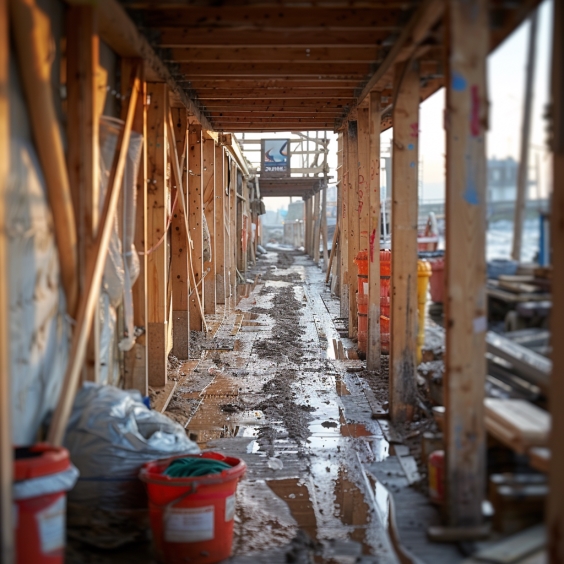以下に、空調工事に関する指摘事項と英会話例を記載します。
1.空調工事に関してよくある指摘事例
- Improper ductwork installation (不適切なダクト工事)
- Incorrect refrigerant charge (不適切な冷媒充填量)
- Inadequate insulation of pipes and ducts (配管とダクトの不十分な断熱)
- Poor condensate drainage (不適切なドレン排水)
- Improper equipment sizing (不適切な機器サイズ選定)
2.空調工事に関してよくある指摘事項とポイントを英語で説明する
まずは音声だけ聞いてみましょう。
HVAC installation is crucial for building comfort and energy efficiency. Here are key points to remember:
- Ductwork: Ensure proper sealing and insulation of ducts. Leakage should not exceed 5% of the system's designed airflow rate.
- Refrigerant charge: Follow manufacturer's specifications for charging. Typically, subcooling should be within ±2°F of the target value.
- Insulation: Properly insulate all refrigerant lines and ducts. For refrigerant lines, insulation thickness is typically 13-19mm depending on pipe size and location.
- Condensate drainage: Install drain lines with a minimum slope of 1:100 (1%) away from the unit. Use proper p-traps where necessary.
- Equipment sizing: Size equipment based on accurate load calculations. Oversizing should not exceed 15% of the calculated load.
- Airflow: Ensure proper airflow across evaporator coils. Typically, aim for 350-450 CFM per ton of cooling capacity.
- Filtration: Install filters with the correct MERV rating as specified. Ensure easy accessibility for maintenance.
- Zoning: In multi-zone systems, balance dampers and airflow to each zone according to design specifications.
- Controls: Properly install and calibrate all thermostats and sensors. Ensure they are not affected by direct sunlight or drafts.
- Noise and vibration: Install appropriate vibration isolators and ensure ductwork is properly supported to minimize noise transmission.
Always refer to project specifications, manufacturer's guidelines, and local building codes, as requirements may vary based on the type of system, building use, and specific performance criteria.
日本語訳:
空調設備の設置は、建物の快適性とエネルギー効率にとって重要です。覚えておくべき重要なポイントは以下の通りです:
- ダクト工事:ダクトの適切なシーリングと断熱を確保します。漏れはシステムの設計風量の5%を超えないようにします。
- 冷媒充填:充填については製造業者の仕様に従います。通常、過冷却度は目標値の±2°F以内であるべきです。
- 断熱:すべての冷媒配管とダクトを適切に断熱します。冷媒配管の場合、断熱材の厚さは配管サイズと場所に応じて通常13-19mmです。
- ドレン排水:ドレン配管はユニットから離れる方向に最小1:100(1%)の勾配で設置します。必要な箇所には適切なPトラップを使用します。
- 機器サイズ選定:正確な負荷計算に基づいて機器のサイズを選定します。オーバーサイジングは計算負荷の15%を超えないようにします。
- 風量:蒸発器コイルを通過する適切な風量を確保します。通常、冷却能力1トンあたり350-450 CFMを目指します。
- フィルトレーション:指定された正しいMERV定格のフィルターを設置します。メンテナンスのために容易にアクセスできることを確認します。
- ゾーニング:マルチゾーンシステムでは、設計仕様に従って各ゾーンへのダンパーと風量のバランスを取ります。
- 制御:すべてのサーモスタットとセンサーを適切に設置し、較正します。直射日光や通風の影響を受けないことを確認します。
- 騒音と振動:適切な防振装置を設置し、騒音伝播を最小限に抑えるためにダクトが適切にサポートされていることを確認します。
常にプロジェクト仕様書、製造業者のガイドライン、および地域の建築基準を参照してください。システムの種類、建物の用途、特定の性能基準によって要件が異なる場合があります。
3.空調工事に関する英会話例
次は英会話例です。こちらもまずは音声を聞いてみましょう。
Project Manager: I've been reviewing the HVAC installation on the third floor. There are several issues we need to discuss.
HVAC Contractor: I understand. What specific concerns have you identified?
Project Manager: First, I've noticed some issues with the ductwork. There seems to be air leakage at some of the joints.
HVAC Contractor: We've sealed all joints with mastic. Are there specific areas where you've detected leaks?
Project Manager: Yes, particularly around the VAV boxes. Can you perform a duct leakage test to ensure we're within the 5% limit?
HVAC Contractor: Certainly. We'll conduct a leakage test and reseal any problematic areas.
Project Manager: Good. I'm also concerned about the refrigerant charge in the VRF system. Have you checked the subcooling?
HVAC Contractor: We've charged the system according to the manufacturer's guidelines. What readings are you seeing?
Project Manager: The subcooling is about 4°F off the target value. Can you recheck and adjust the charge?
HVAC Contractor: Absolutely. We'll verify the charge and make necessary adjustments to bring the subcooling within the ±2°F range.
Project Manager: Excellent. Now, regarding insulation - I've noticed some areas where the refrigerant lines aren't fully insulated.
HVAC Contractor: All lines should be insulated. Can you point out the specific areas you're concerned about?
Project Manager: There are gaps in the insulation near some of the branch connections. Can you ensure all lines have continuous insulation?
HVAC Contractor: Of course. We'll inspect all refrigerant lines and add insulation where needed, paying special attention to the branch connections.
Project Manager: Good. Another issue is the condensate drainage. Some of the drain lines don't seem to have adequate slope.
HVAC Contractor: We aimed for a 1% slope on all drain lines. Are there specific areas that look problematic?
Project Manager: Yes, particularly from the fan coil units in the north zone. Can you check the slope and adjust where necessary?
HVAC Contractor: Certainly. We'll re-check all drain lines and ensure they have at least a 1:100 slope away from the units.
Project Manager: Thank you. Now, about the zoning - have you balanced the airflow to each zone?
HVAC Contractor: We've made initial adjustments, but we haven't done the final balancing yet. Is there a specific concern?
Project Manager: Some occupants in the east zone are complaining about insufficient cooling. Can you verify the airflow to that zone?
HVAC Contractor: We'll check the airflow and damper positions for the east zone and make necessary adjustments.
Project Manager: Excellent. Lastly, I've noticed some vibration noise from the rooftop units. Have you installed all the specified vibration isolators?
HVAC Contractor: We've installed isolators, but we may need to adjust them. We'll inspect and make any necessary modifications to reduce the vibration.
Project Manager: Good. Remember, a properly installed HVAC system is crucial for building comfort and energy efficiency.
HVAC Contractor: Absolutely. We appreciate your thorough inspection. We'll address all these issues immediately and improve our quality control measures going forward.
Project Manager: That's great to hear. Let's schedule a follow-up inspection once you've made these corrections. Keep me updated on your progress.
日本語訳:
プロジェクトマネージャー: 3階の空調設備の設置を確認していたんだが、いくつか話し合う必要のある問題がある。
空調業者: 承知しました。具体的にどのような懸念点を特定されましたか?
プロジェクトマネージャー: まず、ダクト工事にいくつか問題があることに気づいた。一部の接合部で空気漏れがあるようだ。
空調業者: すべての接合部をマスチックでシールしています。具体的に漏れを検出した箇所はありますか?
プロジェクトマネージャー: ああ、特にVAVボックス周辺だ。5%の制限内に収まっていることを確認するためにダクト漏れ試験を実施してくれないか?
空調業者: もちろんです。漏れ試験を実施し、問題のある箇所を再シールします。
プロジェクトマネージャー: よし。VRFシステムの冷媒充填量についても懸念がある。過冷却度をチェックしたか?
空調業者: 製造業者のガイドラインに従ってシステムに充填しました。どのような読み取り値を見ていますか?
プロジェクトマネージャー: 過冷却度が目標値から約4°Fずれている。再確認して充填量を調整してくれないか?
空調業者: もちろんです。充填量を確認し、過冷却度を±2°Fの範囲内に収めるために必要な調整を行います。
プロジェクトマネージャー: 素晴らしい。さて、断熱についてだが - 冷媒配管が完全に断熱されていない箇所がいくつか見られた。
空調業者: すべての配管は断熱されているはずです。具体的に懸念のある箇所を指摘していただけますか?
プロジェクトマネージャー: 一部の分岐接続部近くで断熱材に隙間がある。すべての配管に連続的な断熱材が施されていることを確認してくれないか?
空調業者: もちろんです。すべての冷媒配管を点検し、必要な箇所に断熱材を追加します。特に分岐接続部に注意を払います。
プロジェクトマネージャー: よし。もう一つの問題はドレン排水だ。一部のドレン配管に十分な勾配がないように見える。
空調業者: すべてのドレン配管に1%の勾配を目指しました。具体的に問題がありそうな箇所はありますか?
プロジェクトマネージャー: ああ、特に北ゾーンのファンコイルユニットからのものだ。勾配をチェックして必要に応じて調整してくれないか?
空調業者: もちろんです。すべてのドレン配管を再確認し、ユニットから離れる方向に少なくとも1:100の勾配があることを確認します。
プロジェクトマネージャー: ありがとう。さて、ゾーニングについてだが - 各ゾーンへの風量のバランスは取ったか?
空調業者: 初期調整は行いましたが、最終的なバランス調整はまだ行っていません。具体的な懸念事項はありますか?
プロジェクトマネージャー: 東ゾーンの一部の居住者が冷房が不十分だと訴えている。そのゾーンへの風量を確認してくれないか?
空調業者: 東ゾーンの風量とダンパー位置を確認し、必要な調整を行います。
プロジェクトマネージャー: 素晴らしい。最後に、屋上ユニットからの振動騒音に気づいた。指定されたすべての防振装置を設置したか?
空調業者: 防振装置は設置しましたが、調整が必要かもしれません。点検して振動を減らすために必要な修正を行います。
プロジェクトマネージャー: よし。適切に設置された空調システムは、建物の快適性とエネルギー効率にとって極めて重要だということを忘れないでくれ。
空調業者: もちろんです。徹底的な検査に感謝します。これらの問題にすぐに対処し、今後は品質管理措置を改善します。
プロジェクトマネージャー: それを聞いて安心したよ。これらの修正を行った後で、フォローアップの検査をスケジュールしよう。進捗状況を随時報告してくれ。






